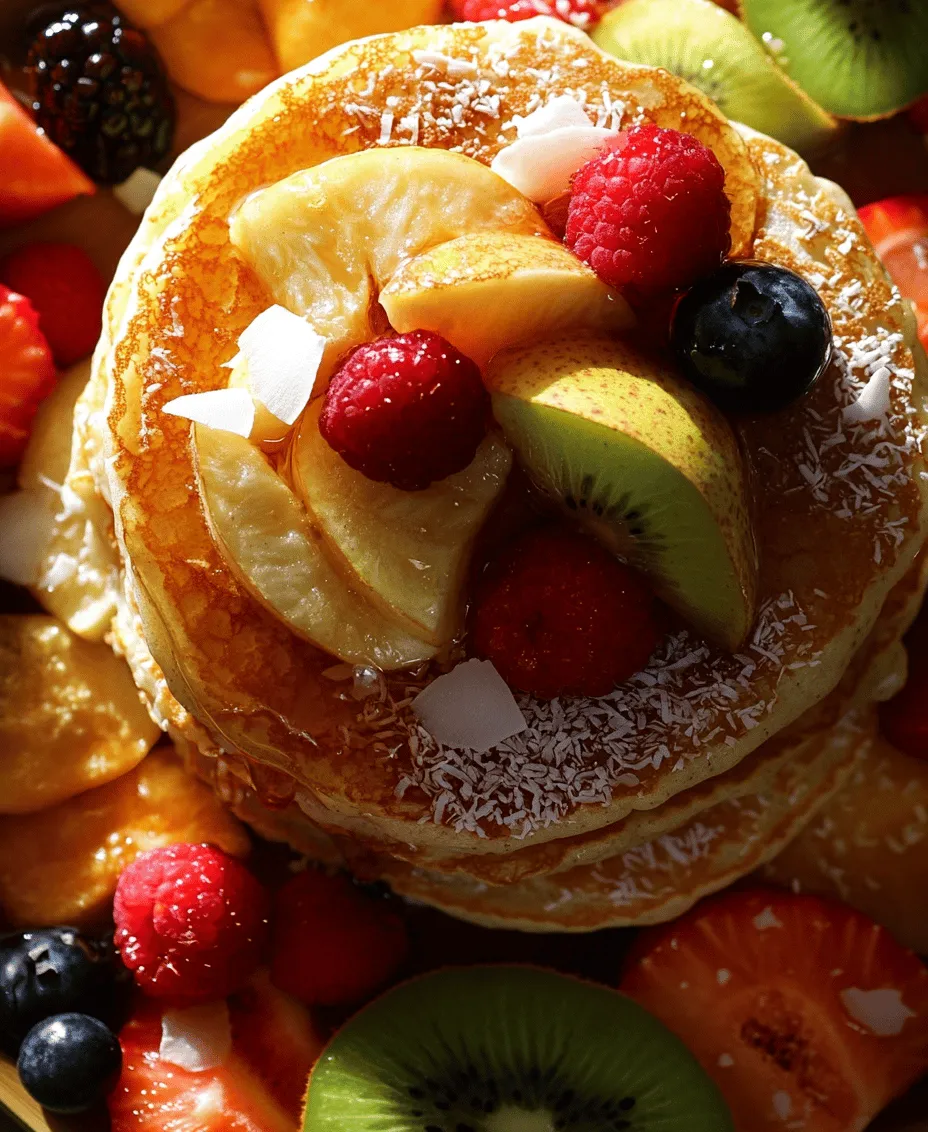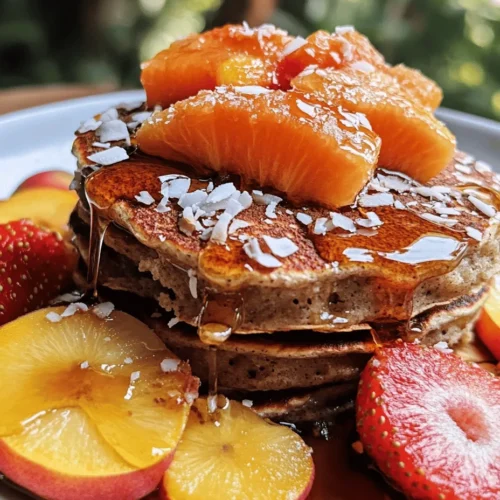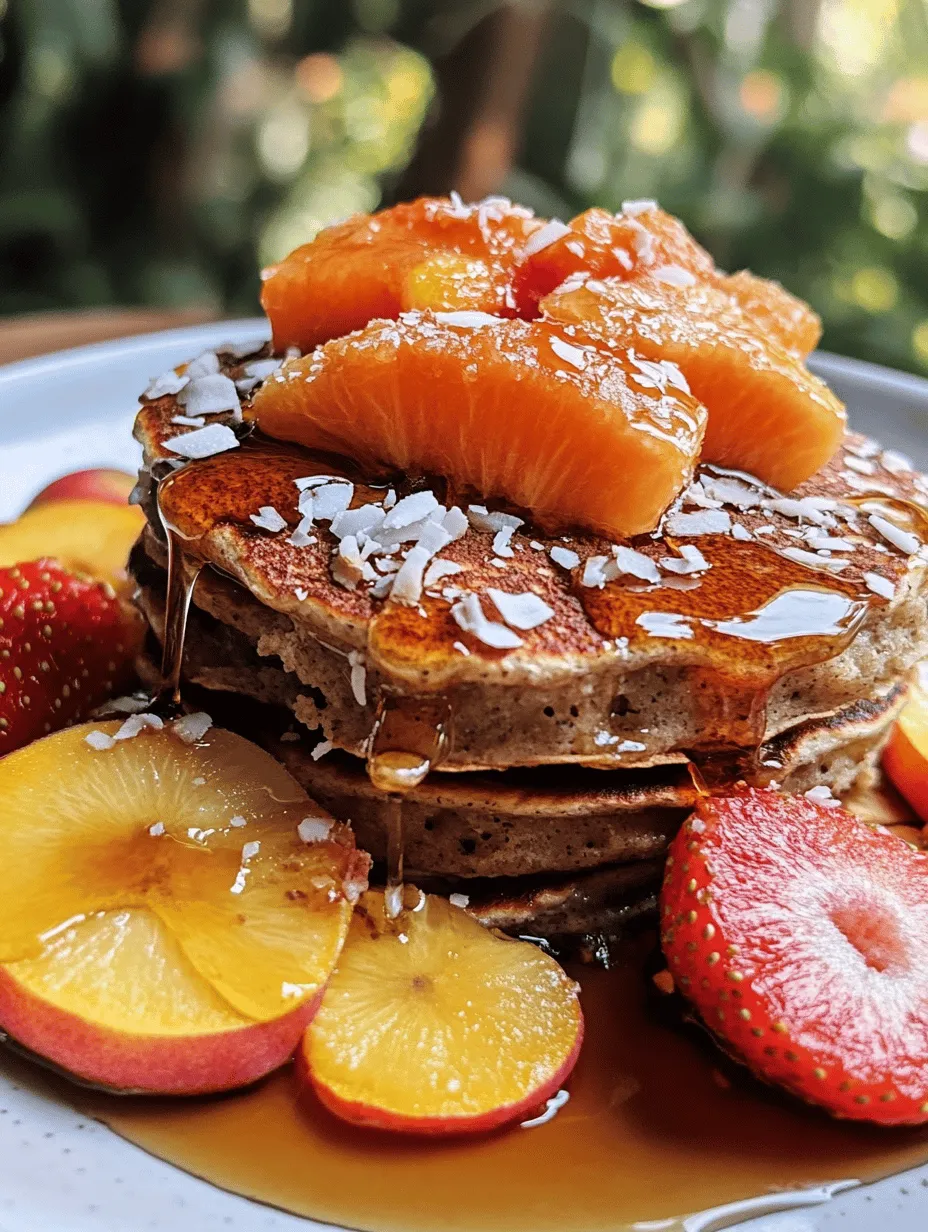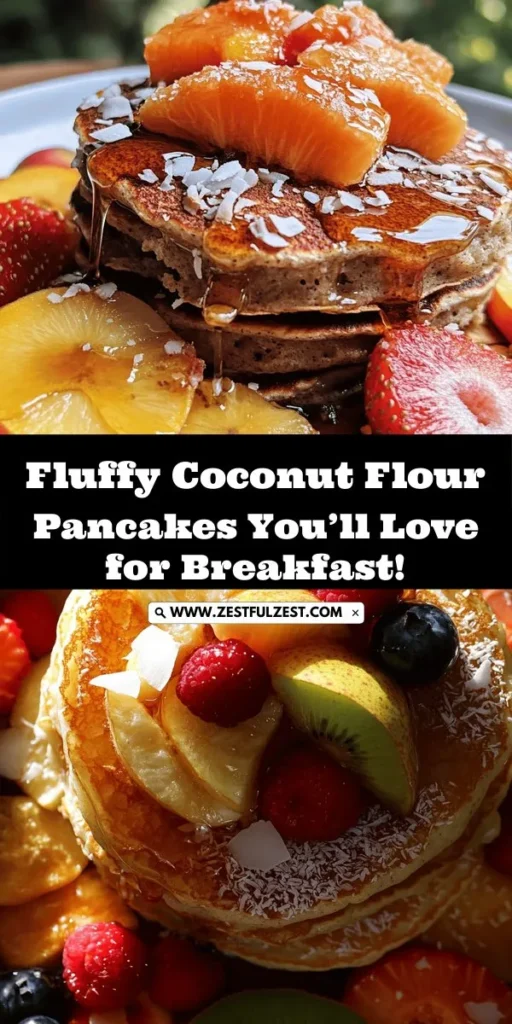Introduction
Are you searching for a breakfast option that is not only delicious but also healthy? Look no further than coconut flour pancakes! These pancakes are gaining popularity among health-conscious eaters, thanks to their light, fluffy texture and the unique flavor profile that coconut flour brings to the table. Whether you’re following a gluten-free diet, managing your carb intake, or simply want to indulge in a tasty treat, coconut flour pancakes are the perfect solution.
Coconut flour is a versatile ingredient derived from the flesh of dried coconuts. It offers a naturally sweet flavor and a fine texture that makes it ideal for creating light and airy pancakes. Unlike traditional wheat flour, coconut flour is high in fiber, low in carbohydrates, and provides a wealth of essential nutrients. This recipe for deliciously fluffy coconut flour pancakes not only satisfies your taste buds but also nourishes your body, making it an easy breakfast option you’ll want to make time and time again.
Understanding Coconut Flour
Before diving into the recipe, let’s take a closer look at coconut flour and why it’s such a fantastic choice for pancake lovers. Coconut flour is made by grinding the dried meat of coconuts into a fine powder. This flour is gluten-free, making it an excellent alternative for those with gluten sensitivities or celiac disease. Additionally, it has a low glycemic index, which means it won’t cause significant spikes in blood sugar levels, making it a smart choice for individuals following a low-carb or ketogenic diet.
Nutritional Profile of Coconut Flour
Coconut flour is an excellent source of dietary fiber, providing approximately 5 grams of fiber per 2-tablespoon serving. This high fiber content supports digestive health and keeps you feeling full longer. Furthermore, coconut flour is rich in healthy fats, particularly medium-chain triglycerides (MCTs), which are known for their quick energy-boosting properties and potential weight management benefits.
When compared to traditional all-purpose flour, coconut flour offers a distinct advantage. While all-purpose flour contains minimal fiber and nutrients, coconut flour is packed with vitamins, minerals, and antioxidants. It’s particularly high in manganese, which plays a crucial role in bone health and metabolism, and it also contains small amounts of iron and potassium.
Benefits of Using Coconut Flour in Recipes
1. Gluten-Free: Ideal for those with gluten intolerance or celiac disease.
2. Low-Carb: A great option for those watching their carbohydrate intake.
3. High in Fiber: Promotes digestion and keeps you satisfied.
4. Rich in Healthy Fats: Supports energy levels and overall health.
5. Delicious Flavor: Adds a subtle sweetness and unique coconut taste to dishes.
Ingredients Breakdown
Now that we understand the benefits of coconut flour, let’s look at the specific ingredients needed for this delightful pancake recipe. Each ingredient plays a crucial role in achieving the perfect fluffy texture and flavor.
– Coconut Flour: The star of our recipe, coconut flour provides a light and airy texture while contributing a delightful coconut flavor. It absorbs moisture more than traditional flour, so you’ll need to adjust the liquid content in your recipe accordingly.
– Salt: A crucial ingredient that enhances and balances flavors. Just a pinch of salt can elevate the sweetness of the pancakes, ensuring that every bite is delicious.
– Baking Powder: This leavening agent is vital for achieving fluffiness in your pancakes. It creates air pockets in the batter during cooking, resulting in light and fluffy pancakes that won’t fall flat.
– Sweetener Options: You can customize the sweetness of your pancakes with various options. Honey and maple syrup both add natural sweetness and a hint of their unique flavors. Coconut sugar is another great choice, providing a caramel-like taste that complements the coconut flour beautifully.
– Eggs: Eggs are essential for binding the ingredients together and contributing to the fluffiness of the pancakes. They also provide protein, making your breakfast more satisfying.
– Unsweetened Almond Milk: This dairy-free alternative adds moisture to the batter. Unsweetened almond milk has a mild flavor that won’t overpower the pancakes, and it keeps the recipe vegan-friendly if you choose to omit the eggs.
– Coconut Oil: Used in cooking and to grease your skillet, coconut oil adds a subtle coconut flavor and healthy fats. It also helps keep the pancakes moist and tender.
– Vanilla Extract: A splash of vanilla extract enhances the overall flavor profile of the pancakes, adding depth and a touch of sweetness.
– Optional Toppings: To elevate your pancake experience, consider adding fresh berries, sliced bananas, or a drizzle of maple syrup. You can also top them with shredded coconut, nuts, or a dollop of yogurt for added texture and flavor.
Step-by-Step Instructions for Perfect Pancakes
Now that we have a clear understanding of the ingredients, let’s move on to the preparation of these delectable coconut flour pancakes. Follow these step-by-step instructions for a flawless pancake experience.
1. Gather Your Ingredients: Start by assembling all your ingredients. Having everything in one place will streamline the cooking process and ensure you don’t forget anything.
2. Sift the Dry Ingredients: In a medium-sized bowl, combine the coconut flour, baking powder, and salt. It’s essential to sift these dry ingredients together to eliminate any lumps and ensure a smooth batter. This step plays a crucial role in achieving light and fluffy pancakes.
3. Mix the Wet Ingredients: In a separate bowl, whisk together the eggs, unsweetened almond milk, melted coconut oil, honey (or your chosen sweetener), and vanilla extract until well combined. Make sure the coconut oil has cooled slightly before adding it to avoid cooking the eggs.
4. Combine Wet and Dry Ingredients: Gradually add the wet mixture to the dry ingredients, stirring gently until just combined. Be careful not to over-mix, as this can lead to dense pancakes. The batter should be thick yet pourable; if it’s too thick, you can add a little more almond milk to reach your desired consistency.
5. Let the Batter Rest: Allow the batter to rest for about 5-10 minutes. This resting period allows the coconut flour to absorb moisture fully, which will help your pancakes achieve optimal fluffiness.
6. Preheat Your Skillet: While the batter rests, preheat a non-stick skillet or griddle over medium heat. If you’re using a regular skillet, lightly grease it with coconut oil to prevent sticking.
7. Cook the Pancakes: Pour about 1/4 cup of batter onto the skillet for each pancake. Cook until bubbles form on the surface, and the edges appear set, about 2-3 minutes. Carefully flip the pancake and cook for an additional 2-3 minutes on the other side until golden brown.
8. Repeat and Serve: Repeat the process with the remaining batter, adjusting the heat as necessary to avoid burning. Serve the pancakes warm with your choice of toppings, and enjoy a delightful, healthy breakfast!
By understanding the ingredients, their roles, and following these detailed instructions, you’re well on your way to creating deliciously fluffy coconut flour pancakes that are sure to impress your family and friends. Get ready to indulge in a breakfast that is not only satisfying but also nourishing!

Tips for Mixing Wet Ingredients Properly
To achieve the perfect texture in your coconut flour pancakes, it’s essential to mix the wet ingredients correctly. Start by whisking the eggs in a medium bowl until they are fully combined and slightly frothy, which adds air and helps with fluffiness. Next, add in your milk of choice—whether it’s almond, coconut, or dairy—and the melted coconut oil. Whisk these ingredients together until they are smooth and well incorporated.
If you’re using any sweeteners, such as honey or maple syrup, mix them in at this stage to ensure even distribution throughout the batter. Avoid over-mixing; you want to blend the ingredients just enough to eliminate lumps without creating a dense batter. This technique will yield light and fluffy pancakes that are a joy to eat.
Discussing the Resting Period of the Batter and Its Effects on Texture
Allowing your pancake batter to rest is a crucial step that can significantly enhance the final product. After mixing the wet and dry ingredients, let the batter sit for about 10 to 15 minutes. During this resting period, the coconut flour absorbs the moisture from the liquids, leading to a thicker and more cohesive batter. This absorption helps create a better texture in the pancakes, allowing them to rise more during cooking, resulting in extra fluffiness.
Resting also allows the flavors to meld together, enhancing the overall taste of your pancakes. If you’re in a rush, you can skip this step, but giving your batter the time to rest will yield superior results that are well worth the wait.
Cooking Techniques for Optimal Results
When it comes to cooking your coconut flour pancakes, the technique is just as important as the ingredients. First, choose a non-stick skillet or griddle to prevent sticking. Preheat your skillet over medium heat for several minutes before adding any oil.
For oil, you can use coconut oil for a complementary flavor or any neutral oil like avocado or canola oil. Once the skillet is hot, add about a teaspoon of oil and swirl it around to coat the surface evenly.
Pour a small amount of batter onto the skillet, roughly 1/4 cup per pancake. Cooking in batches ensures you have enough space to flip without crowding the pan.
Ideal Skillet Temperature and Oil Usage
The ideal temperature for cooking pancakes is critical to achieving that perfect golden-brown exterior. Too high of a heat will cause the outside to burn before the inside is cooked, while too low will result in pale, undercooked pancakes.
A good rule of thumb is to preheat your skillet to medium heat, which usually falls between 350°F to 375°F. To test if your skillet is ready, sprinkle a few drops of water on the surface; if they sizzle and evaporate quickly, your skillet is hot enough.
When it comes to oil, start with enough to lightly coat the pan. You can add more oil as needed between batches, but be cautious not to drown the pancakes in oil, as this can lead to frying rather than cooking, altering their texture.
Visual Cues for Flipping Pancakes at the Right Time
Knowing when to flip your pancakes is crucial for achieving that ideal fluffiness. Watch for bubbles forming on the surface of the pancakes; they will start to appear after about 2-3 minutes of cooking. Once the edges look set and you see bubbles popping on the surface, it’s time to flip.
Using a spatula, gently slide it under the pancake and lift it slightly to check the color on the underside. A golden-brown hue means it’s cooked through enough to flip. If it’s too pale, give it another minute before attempting to turn it over.
Cook for an additional 2-3 minutes on the other side until golden brown as well. Repeat this process until all your batter is used, adjusting the heat as necessary if pancakes are cooking too quickly or slowly.
Serving Suggestions for a Delightful Presentation
Presentation can elevate your coconut flour pancakes from simple breakfast fare to a special brunch treat. Start by stacking the pancakes in a neat pile on a serving plate. You can layer them with fresh fruits like sliced bananas, strawberries, or blueberries for a pop of color and flavor.
Drizzle with maple syrup or a homemade fruit compote for added sweetness. If you want to get creative, add a dollop of Greek yogurt or whipped cream on top, and sprinkle with nuts or seeds for some crunch. For an extra touch, you can garnish with a dusting of powdered sugar or a sprinkle of cinnamon to enhance the overall visual appeal.
Health Benefits of Coconut Flour Pancakes
Coconut flour pancakes are not just delicious; they also come with numerous health benefits that make them a great choice for breakfast.
Overview of the Nutritional Advantages
Coconut flour is rich in nutrients and offers several advantages over traditional wheat flour. It is high in fiber, low in carbohydrates, and gluten-free, making it a suitable option for those with dietary restrictions or looking to maintain a healthier lifestyle.
High Fiber Content and Its Benefits for Digestion
One of the standout features of coconut flour is its impressive fiber content. A single serving of coconut flour contains around 5 grams of fiber, which is beneficial for digestion. Fiber aids in regular bowel movements and helps prevent constipation, promoting overall gut health. A high-fiber diet can also help you feel fuller for longer, making it easier to manage your weight.
Low Glycemic Index and Its Impact on Blood Sugar Levels
Coconut flour has a low glycemic index, which means it causes a slower rise in blood sugar levels compared to high-carb alternatives. This characteristic is particularly beneficial for individuals managing diabetes or those looking to maintain stable energy levels throughout the day. By choosing coconut flour pancakes, you can enjoy a satisfying meal that won’t spike your blood sugar.
Suitable for Various Diets (Gluten-Free, Paleo, Keto)
Coconut flour pancakes fit well into various dietary lifestyles. They are gluten-free, making them an excellent option for those with gluten sensitivities or celiac disease. Additionally, they align perfectly with paleo and keto diets, as they are low in carbohydrates and high in healthy fats. This versatility allows everyone to enjoy a delicious pancake breakfast without compromising their dietary restrictions.
Discussion on Portion Control and Healthy Toppings
While coconut flour pancakes are healthier than traditional pancakes, portion control is still key. They can be quite filling due to their fiber content, so consider serving one or two pancakes per person, paired with fresh fruits or nuts for added nutrients. Opt for natural toppings like fresh fruit, yogurt, or nut butter instead of sugary syrups to keep the meal wholesome and nutritious.
Customizing Your Coconut Flour Pancakes
One of the joys of cooking is the ability to customize recipes to suit your taste preferences. Coconut flour pancakes are no exception and can be easily adapted to create a variety of delicious flavors.
Ideas for Incorporating Different Flavors
Add a twist to your pancake batter by incorporating spices or zests. A teaspoon of cinnamon, nutmeg, or vanilla extract can enhance the flavor profile significantly. For a refreshing touch, consider adding a tablespoon of lemon or orange zest to the batter, which brightens the pancakes and adds a citrusy aroma.
Suggestions for Mix-Ins
For those who love a little extra in their pancakes, mix-ins can elevate the dish to new heights. Chocolate chips, blueberries, or diced apples can be folded into the batter for delightful surprises in every bite. Be sure to adjust the amount of liquid slightly if you’re adding ingredients that contain moisture, like fruits.
Creative Toppings Beyond the Basics
While maple syrup is a classic pancake topping, there are many creative alternatives to explore. Try serving your pancakes with a dollop of Greek yogurt topped with honey and nuts for a protein boost. Nut butters, such as almond or cashew, can add richness and flavor, while homemade syrups made from pureed fruits can provide a unique twist.
Storing and Reheating Pancakes
If you have leftover pancakes, proper storage will ensure they stay fresh and delicious for later enjoyment.
Best Practices for Storing Leftover Pancakes
Allow your pancakes to cool completely before storing them. Once cooled, stack them with parchment paper in between each pancake to prevent sticking. Place the stack in an airtight container or resealable plastic bag and store them in the refrigerator for up to 3 days or in the freezer for up to 3 months.
Tips for Reheating to Maintain Fluffiness and Flavor
To reheat your pancakes, the oven is the best method for maintaining their fluffiness. Preheat your oven to 350°F (175°C) and place the pancakes on a baking sheet. Cover them with aluminum foil to prevent them from drying out, and heat for about 10 minutes or until warmed through. Alternatively, you can microwave individual pancakes for about 20-30 seconds, but this may result in a softer texture.
Creative Ways to Repurpose Leftover Pancakes
If you find yourself with leftover pancakes, consider getting creative. Use them to make pancake sandwiches by layering them with nut butter and sliced bananas or berries. You can also crumble them into yogurt for a breakfast parfait or use them as a base for a savory dish topped with eggs and avocado.
Conclusion
Coconut flour pancakes are not only a delicious breakfast option but also a versatile and nutritious one. Their unique texture, combined with a variety of customization possibilities, makes them a favorite for many households. From mixing in your favorite flavors to experimenting with toppings, the possibilities are endless.
Encourage your loved ones to try this recipe and make it their own, whether by adding spices or serving with an array of toppings. The joy of homemade breakfasts lies in the ability to create something special that caters to your tastes and dietary needs. So, gather your ingredients, follow the steps, and enjoy the delightful experience of making and savoring coconut flour pancakes. Your mornings will never be the same!



